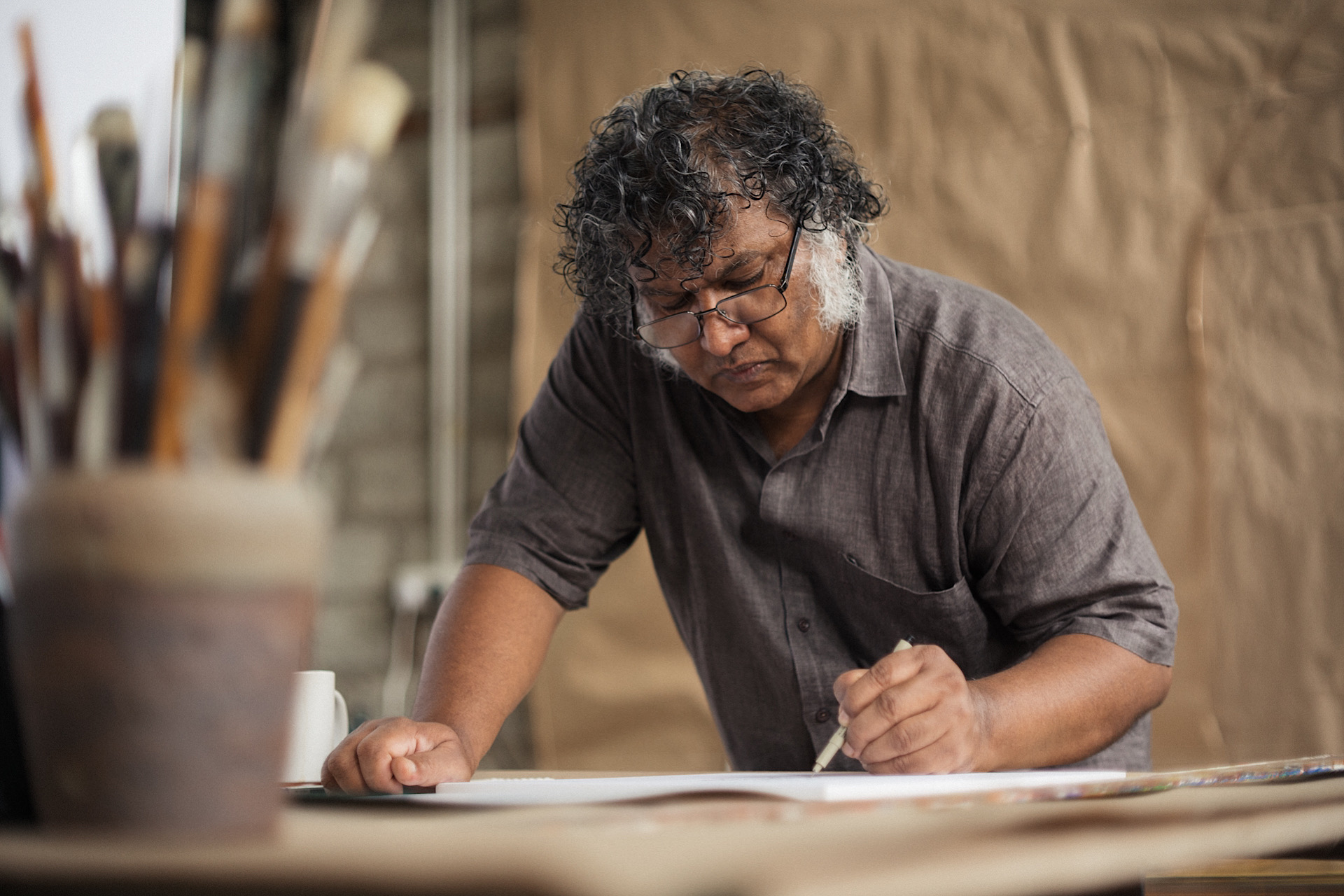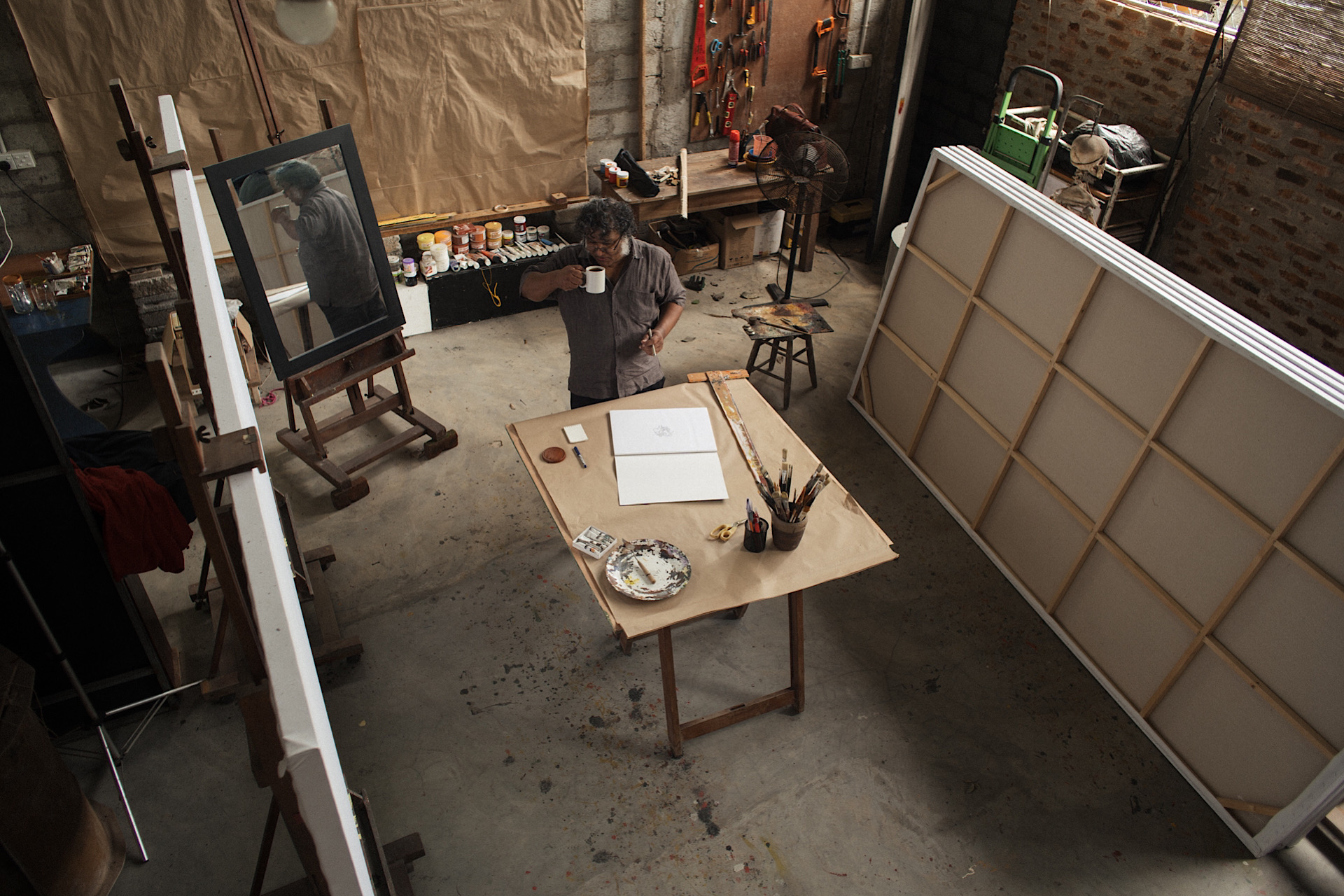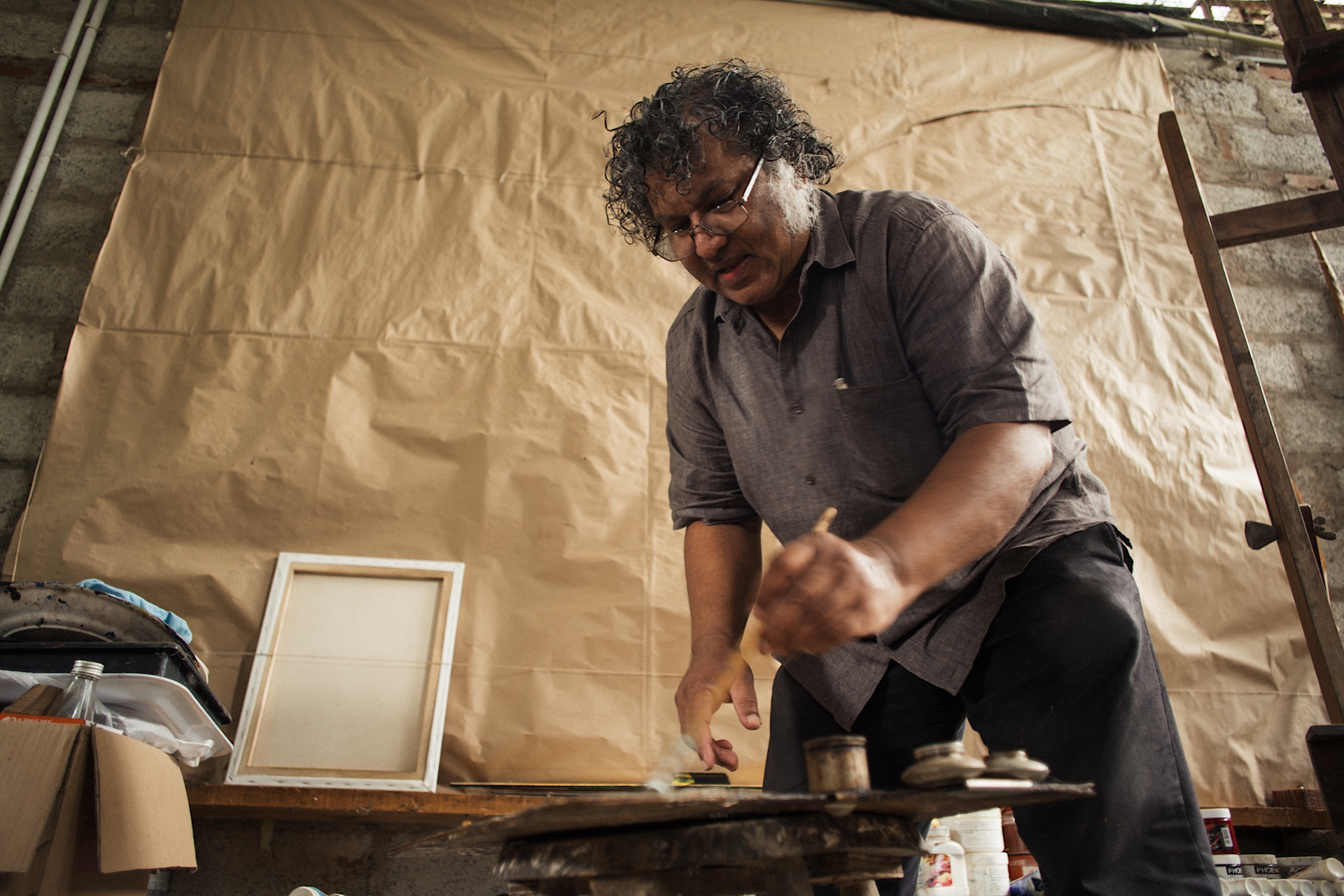The Artist
Chandragupta Thenuwara
Chandraguptha Thenuwara, an artist and activist, known for his unapologetic critique of successive governments. Thenuwara was a witness to the horrors of Black July, the pogrom that left thousands of Tamils murdered in 1983, and explains why he memorialises it every year with an exhibition in Colombo. His work, deeply influenced by the events of that period, has evolved from creating joyful paintings to producing politically charged pieces that memorialise the victims of violence. One of Thenuwara’s most notable contributions is his annual exhibition that commemorates the events of Black July, a reminder of the unspoken atrocities that remain uncommemorated. "I always remind them what happened, not to happen again," he states, underscoring the importance of memory in his work. His art is a form of resistance—challenging the status quo, questioning power, and calling for a society where democracy and respect for others' opinions can flourish.


Transcript and translations
Language
Subjects discussed
After 1983, I can’t paint happy paintings any more
And I saw one monk. Standing in front of the door. And other looters are waiting to enter that shop. They can’t enter because it’s locked. And they ask the military person shoot the padlock. So they shoot and it’s opened.Then they looted everything. Textiles, and you know, TVs, and everything. Whatever. Whatever comes to their hand, they were looted.
This is another structure I wanted to… another sculpture now. And…
Is this a barrel?
Kind of. No This is the…First we tried like a…This will help to create that Venice Biennale work. It is there in that studio. So, now, I have to use this one otherwise it will…Yeah, I can do something with that space. And this is the space we are going to have my sculptural work.
Tell us your personal experience of Black July.
It happened in nineteen eighty-three, July, twenty third. When the news came that the thirteen soldiers [were] killed I was on my way to Colombo to my freelance work at the Wijaya Publications. But early morning when I came out from my Nugegoda boarding place, so in the bus I saw the burning. That Kalpana… Where we eat normally, our thoseys and other things. It was burning. I thought it’s an accident, might be. Everybody is watching it. So bus moved. And so in Thimbirigasyaya side two people entered and you know, asking ‘baldiya’ and ‘pen “What is this?” and you know if they can’t pronounce it properly, that’s the way they identified without checking the identity card.
So you saw it unfolding with your eyes?
Yeah, yeah. They were taken out. Some might be two or three people, they were taken out. I don’t know what happened to them I saw some… the shops are written in, on those walls and you know, saying that this belongs to the Sinhalese family. This is the Sinhala owner’s shop. Not to burn them, their houses, you know. With the Sri Vihar there at that time. One shop occupied by the police person. And because that shop run by the Tamil. Later it turn to the Sinhalese owned shop, and I’m seeing all the Tamil owned shops are burning or looted.
So how did, like you were walking around and seeing everything burning?
Yeah.
How did you react?
We can’t react anything, you know? Because everybody’s in the kind of looting mode in the road. You can’t say anything to stop that. They will kill you.
So how are you feeling? What did you feel?
You are afraid. Yeah, I, fear, you know? [You’re] feeling the fear. You don’t know.You have to survive, you know? Otherwise if you’re talking anyone against them, they will kill you. You’re a pro-Tamil or someone.
This is for me to make that table, right?
So, then we can sit here and use it? Till it comes here, right? Without any trouble, right? We’ll keep that, that way and measure and see how it will be. Yeah, drop it below.
So you have to wait for new shipments, canvas.
Yeah.
That is why you have to find [an] alternative way of doing things. That is why sometimes sculptures or whatever. Other things. Drawings, you know. Than the painting.
Was twenty-seven years people lived here without power and without light without, you know, gas, anything. Still they are with the problem with the military. You have no problem with that. But military walking around your Colombo area over there, you feel militarised, you know? And you don’t lost, you don’t have power for one hour, or you have, you don’t have fuel for one day, you’re changing the government.
All those things, most of the killings and the setting fire done by the organised mob. They went with their list. Who gave them list? Around six o’clock, the army is going with their armed vehicle and saying that’s enough now, six o’clock. Yeah? So they allowed people to loot. How you can forget about those things?
For me, for my transformation art is very important. You know as a person, for me personally. But beautiful things, after nineteen eighty-three, I couldn’t make beautiful things. You know, my subject matter was changed. When I, my study time in… in Sri Lanka, I paint my poor figures, ballerinas, and you know, dance, you know, happy paintings you can paint. But, after nineteen eighty-three I can’t paint happy paintings anymore.
Hello Thenu. How are you? So much happening.
Yeah, so much happening, a little bit away. Gave me a good chance for a look at from kind of satellite view.
Good, right? Yes. It’s difficult, right?
I also travel by bus or three-wheeler. The car is parked at home.
It’s very interesting to be here, this time…
Okay, yeah.
This time, in Sri Lanka, seeing your work.
This is a new camouflage. It’s coming out. Now you can see the tiny red lines are coming up,
Okay.
With the… my usual green, black and yellow.
This must have taking you a while.
Yeah.
It’s beautiful.
Now we have more yellow poles. Where the protests are?
Yes.
There will be more yellow poles, barricades.
Yeah.
I first introduced in two thousand and seven as a neobarrelism.
Yes, I remember.
That yellow poles.
Yes, I remember.
Now it’s become a post-neobarrelism now.
Right.
But it still continues. It might be, it will be, for, till two thousand and thirty, might be (laughs). Until we democratise. You know? Ourselves. Not the government. You know? First we have to democrat… Practise our democracy…
True.
Yeah. So, not to be violent. How to act and how to criticise. How to respect others’ opinions. We are not patient. You know, we’re not… We are, we are not patient enough, but we are sick.
Hi. How are you? Hello. Hi. Hi.
Every year I remind, commemorating the uncommemorative things. How pogrom happened. You know, you can, people come there and they remind… I always reminding them what happened.
Not to happen again, it. You can’t commemorate it, but it’s a uncommemorative event. So that is why this date, this twenty third of July is very important to have my exhibition. It marks the bloodiest thing [that] happened in Sri Lankan history. By the organised crime. By the government.
After 1983, I can’t paint - Sinhala
මම දැක්කා එක හාමුදුරු නමක්. දොර ඉස්සරහ හිටගෙන ඉන්නවා. අනිත් කොල්ලකරුවන් ඒ කඩේට ඇතුල්වෙන්න බලාගෙන ඉන්නවා. අඟුල් දාල නිසා ඒකට ඇතුල්වෙන්න බැහැ. ඒ අය එතන හමුදාවෙ කෙනෙකුගෙන් ඉල්ලුවා ඒ අඟුලට වෙඩි තියන්න කියලා.
ඉතින් එගොල්ලෝ වෙඩිතියලා ඒක ඇරියා. ඊට පස්සෙ හැමදේම කොල්ලකෑවා. රෙදි, ටීවී, හැමදෙයක්ම. ඕන දෙයක්. අතට ආපු ඕන දෙයක්, ඒ අය කොල්ලකෑවා.
මේක තවත් සැකිල්ලක්, මට ඕන වුණ, දැන් තවත් මූර්තියක්. සහ,
මේක බැරල් එකක් ද?
තරමක් දුරට. නෑ මේක තමයි…
ඉස්සෙල්ලම අපි උත්සහ කලේ…
මේක අර වෙනිසියේ බයෙනාලේ එකට තියෙන නිර්මාණය හදන්න උදව් වෙයි. ඒක අර ස්ටුඩියෝ එකේ තියෙනවා. ඉතින්, දැන්, මට මේක පාවිච්චි කරන්න වෙනවා, නැත්තන්. ඒකෙන්… ඔව්, මට ඒ ගලෙන් මොකක් හරි කරන්න පුළුවන්.
මේ අවකාශයේ තමයි මගේ මූර්ති කටයුතු තියන්න යන්නේ.
කළු ජූලිය ගැන ඔබේ පුද්ගලික අත්දැකීම් අපිට කියන්න.
ඒක, සිද්ධවුණේ එක්දාස් නමසිය අසූ තුනේ, ජූලි, විසි තුන් වෙනිදා.
හමුදා සෙබළුන් දහතුන් දෙනෙකු ඝාතනය කරපු බව ප්රවෘත්තිය එනකොට මම කොළඹට එන ගමන් විජය ප්රකාශකයන් එක්ක මගේ තිබුණ වැඩ කරන්න. ඒත් උදේ පාන්දර මම එළියට ආවම මගේ නුගේගොඩ බෝඩිමෙන්, ඉතින් මම බස් එකේ දැක්කා කල්පනා [ආපනශාලාව] ගිනි ගන්නවා.
ඒ අපි සාමාන්යයෙන් තෝසේ, සහ අනිත් කෑම, කාපු තැන. ඒක ගිනිගන්නවා. මම හිතුවේ හදිසි අනතුරක් කියලා. හැමෝම ඒක දිහා බලාගෙන හිටියා. ඉතින් බස් එක ගියා.
ඊට පස්සේ තිඹිරිගස්යාය පැත්තේ මිනිස්සු දෙන්නෙක් බස් එකට නැගලා අහන්න පටන් ගත්තා ‘බාල්දිය’ සහ [පෑනක් පෙන්නලා අහනවා], ‘මේ මොකද්ද?’. දන්නව නේ, ඒවා හරියට උච්චාරණය කරන්න බැරි නම්, එහෙම තමයි ඒ අය [දෙමළ අය] අඳුනගත්තේ හැඳුනුම්පට බලන්නේ නැතුව.
ඉතින් ඔබ මේවා සිද්ධවෙනවා ඔබේ ඇස් දෙකින්ම දැක්කා?
ඔව්, ඔව්! ඒ අයව එළියට අරගත්තා. සමහර, දෙතුන් දෙනෙක් වෙන්නැති, ඒ අයට එළියට අරගත්තා.
මම දන්නේ නෑ ඒ අයට මොනවා වුණා ද කියලා. මම දැක්කා සමහර කඩවල ලියලා තියෙනවා ඒවයේ,
බිත්ති වල, දන්නව නේ, කියලා මේක අයිති සිංහල පවුලකට කියලා. මේක සිංහල අයිතිකාරායෙක් ගේ කඩයක්. මේකට ගිනි තියන්න එපා, ඒ අයගේ ගෙවල් වලට. දන්නවා නේ?
එතන ඒ කාලේ ශ්රී විහාර් එකත් තිබුණා. එක කඩේක පොලිසියේ කෙනෙක් හිටියා. ඉතින් ඒ කඩේ
කලේ දෙමළ කෙනෙක්. එයා දැන් ඒක සිංහලයන්ට අයිති කඩයක් වෙන්න ඉඩ දුන්නා.
දැන් මට පේනවා හැම දෙමළ කඩයක් ම එක්කෝ ගිනිගන්නවා නැත්තන් කොල්ලකාලා.
ඉතින් කොහොමද, ඔබ එතකොට, වටේම ඇවිදිනකොට හැමදේම ගිනි ගන්නවා පේනවා?
ඔව්.
ඔබ එතෙන දි ප්රතිචාර දැක්වුයේ කොහොමද?
අපිට කිසිම ප්රතිචාරයෙක් දක්වන්න බැහැ. මොකද හැමදෙනාම මේ නිකන්, කොල්ලකන මානසිකත්වයෙන් පාරෙ ඉන්නේ. ඒක නවත්තන්න පුළුවන් කිසිදෙයක් අපිට කියන්න බැහැ.
ඒ අය ඔබව මරලා දායි. අපිට හරිම බයයි.
ඉතින් ඔබට දැනුණේ කොහොම ද? ඔබට දැනුණේ මොකද්ද?
ඔව්, මට, බය, දන්නවනේ? බය තමයි දැනෙන්නේ. දන්නේ නැහැ නේ. කොහොම හරි බේරෙන්න ඕනේ නේ? නැත්තන්, ඔයා ඒ අයට විරුද්ධව කාට හරි කතා කළොත්, ඔයාව මරලා දායි. ඔබ දෙමළ හිතවාදී හෝ කවුරුහරි නම්.
මේක මට, අර මට මේසෙ හදන්න, නේ?
එතකොට අපිට පුළුවන් නේ, මෙතන ඉඳගෙන…
පාවිච්චි කරන්න?
මෙතෙන්ට එනකන්ම නේ?
කරදරයක් නැතුව, නේ?
එහෙම අර, අරකත් තියලා අපි මැනලා බලමු කොහොමද වෙන්නේ කියලා. පල්ලෙහාට දාන්න. ඉතින් බලාගෙන ඉන්න වෙනවා අළුත් තොග, කැන්වස්.
නිර්මාණය කරන්න.
ඔව්.
ඒකයි විකල්පයක් හොයාගන්න සිද්ධවෙන්නේ, වැඩ කරන්න විදිහක්.ඒකයි සමහර වෙලාවට මූර්ති
හරි මොකක් හරි [නිර්මාණය කරන්නේ].
වෙන දේවල්.
ඇඳීම්, දන්නවා නේ? ඊට පස්සේ, චිත්ර.
අවුරුදු විසි හතක් මිනිස්සු මෙහෙ ජීවත් වුණා විදුලිය නැතිව සහ ලයිට් නැතිව. දන්නවා නේ, ගෑස්, කිසි දෙයක් නැතිව. තාම ඒ අයට හමුදාව එක්ක ප්රශ්ණ තියෙනවා. ඒවත් එක්ක ප්රශ්ණයක් නෑ [ඒ අයට].
ඒත් හමුදාව ඒ අයගේ කොළඹ පැත්තේ ඇවිද්දොත්, ඒ අයට මිලිටරිකරණයක් දැනෙනවා, දන්නවා නේ? ඊට පස්සෙ ඔබට නැතිවෙලා නම්, පැයකට විදුලිය ඔබට නැතිවෙලා නම්, එහෙම නැත්තම්, ඔබට දවසකට ඉන්ධන නැත්නම්, ආණ්ඩුව මාරුකරන්න යනවා.
ඔය ඔක්කොම, ඔය ඝාතන වැඩි හරියක් සහ ගිනි තැබීම් සංවිධානාත්මක කල්ලි මගින් සිදු කරපු, ඒ අය ගියේ ලැයිස්තුවක් එක්ක.
කවුද ඒ අයට ලැයිස්තුවක් දුන්නේ?
හවස හයට විතර, හමුදාව යනවා ඒ අයගේ සන්නද්ධ වාහනේකින්. දැන් ඔය ඇති, වෙලාව හයයි කියලා.
හරි?
ඉතින් ඒගොල්ලෝ ඉඩ දුන්නා මිනිස්සුන්ට කොල්ලකන්න.
කොහොමද ඔය දේවල අමතක කරන්නේ?
මට, මගේ පරිවර්තනයට, කලාව ඉතා වැදගත් වෙනවා. පුද්ගලයෙක් හැටියට, පෞද්ගලිකව මට.
ඒත් ලස්සන දේවල්, එක්දාස් නමසිය අසූ තුනෙන් පස්සේ, මට ලස්සන දේවල් නිර්මාණය කරන්න බැහැ.
දන්නවා නේ, මගේ මාතෘකා වෙනස් වුණා. මම ප්රාග් නුවර ඉගෙන ගන්න කොට…ලංකාවේ, මම අඳිනවා මගේ දුප්පත්…මනුශ්ය රූප, බැලරිනා, සහ දන්නවා නේ, නැටුම්, සතුට ගේන චිත්ර අඳින්න පුළුවන්.
ඒත්, එක්දාස් නමසිය අසූ තුනෙන් පස්සේ මට තවත් සතුට ගේන චිත්ර අඳින්න බැහැ. හුඟක් දේවල් සිද්ධ වෙනවා. ඔව්, හුඟක් දේවල් සිද්ධ වෙනවා, තව පොඩ්ඩක් එහා.
ඒක මට හොඳ අවස්ථාවක් දුන්නා
බලන්න
හරියට චන්ද්රිකාවක දෘෂ්ටියෙන් වගේ.
හොඳයි, නේද? ඔව්. ඒක අමාරුයි, නේද?
මාත් බස් එකේ හරි ත්රීවීල් එකේ හරි තමයි යන්නේ. කාර් එක ගෙදර නවත්තලා.
හරිම සිත්ගන්නා සුළුයි, මේ සැරේ,
ඔව්, ඔව්. මේ සැරේ, ලංකාවේ, ඔබේ නිර්මාණ දැකීම.
මේක අළුත් කැමෝ එකක්
ඒක එලියට එනවා.
දැන් ඔබට පේනවා ඇති පොඩි රතු ඉරි උඩට එනවා,
ඔව්.
මගේ සුපුරුදු කොළ, කළු, සහ කහ එක්ක.
ඔව්.
මේකට හුඟ කාලයක් යන්න ඇති නේද?
ඔව්.
ඒක හරිම ලස්සනයි.
දැන් අපිට තියෙනවා තව
කහ පාට පොලු.
විරෝධතා තියෙන තැන?
ඔව්.
එතන තවත් කහ පොලු බාධක තියෙයි.
ඔව්.
මම දෙදාස් හතේ ඉස්සෙල්ලාම හඳුන්වාදුන්නේ නව-බැරල්වාදයක් කියලා.
ඔව්, මට මතකයි.
ඒ කහ කෝන්.
ඔව්, මට මතකයි.
දැන් ඒක පශ්චාත් නව-බැරල්වාදයක් වෙලා. නේද?
හරි.
ඒත් ඒක දිගටම සිද්ධවෙනවා. වෙන්න පුළුවන්, වෙනවා,
තව,
දෙදාස් තිහ වෙනකම් වෙන්න පුළුවන්. අපි ප්රජාතන්ත්රවාදී වෙනකම්.දන්නවා නේ? අපි. රජය නෙමෙයි.
දන්නවා නේ? ඉස්සෙල්ලා අපි ප්රජාතන්ත්රවාදී [වෙන්න ඕනේ]. අපේ ප්රජාතන්ත්රවාදය පුරුදු කරන්න ඕනේ.
ඇත්ත.
ඔව්.
ඉතින්, ප්රචණ්ඩකාරී නොවෙන්න. කොහොමද ක්රියා කරන්නේ, කොහොමද විවේචනය කරන්නේ,
අන් අයගේ මතවලට ගරු කරන්නේ කොහොමද? අපිට ඉවසිලිවන්තකම නෑ. දන්නවා නේ, අපි නෑ…
අපි, අපේ ඉවසිලිවන්තකම මදි, ඒත් අපි රෝගී වෙලා.
හලෝ එඩ්! ඔයාට කොහොමද?
ආහ් හලෝ හලෝ!
හැම අවුරුද්දෙම මම මතක් කරනවා,
අනුස්මරණය නොවන දේවල් අනුස්මරණය කරලා.
සංහාරය සිද්ධ වුණේ කොහොමද.
දන්නව නේ, ඔබට පුළුවන්, මිනිස්සු එතෙනට ඇවිල්ලා ඒ අය මතක් කරනවා.
මම හැමතිස්සෙම ඒ අයට මතක් කරනවා මොකද වුණේ කියලා. ඒක ආයෙත් නොවෙන්න.
ඒක අනුස්මරණය කරන්න බැහැ,ඒත් ඒක අනුස්මරණය කළ යුතු සිදුවීමක්.
ඒක නිසයි මේ දිනය, මේ ජූලි විසි තුන් වෙනිදා ඉතා වැදගත් වෙන්නේ.
මගේ ප්රදර්ශණය පවත්වන්න. එය සටහන් කරලා තියෙන්නේ
ශ්රී ලාංකීය ඉතිහාසයේ වඩාත්ම ලේ තැවැරුණු සිදුවීමයි, සංවිධානාත්මක අපරාධකරුවන්, රජය විසින් සිදුකරපු.
After 1983, I can’t paint
நான் ஒரு பிக்குவைப் பார்த்தேன். கதவுக்கு முன்னால் நின்றார்
மற்றக் கொள்ளையர்கள் கடைக்குள் நுழையக் காத்திருந்தார்கள்
கடை பூட்டியிருந்ததால் நுழைய முடியவில்லை.
அவர்கள் ஒரு ராணுவ உறுப்பினரை பூட்டைச் சுடச் சொல்லிக்கேட்டார்கள்.
அவர் சுட்டுப் பூட்டைத் திறந்தார். அவர்கள் அனைத்தையும் கொள்ளையடித்தனர். துணிகள், தொலைக்காட்சிகள், எல்லாவற்றையும் எடுத்தார்கள். கையில் கிடைத்த எல்லாவற்றையும் கொள்ளையடித்தனர்
இந்த இடத்தைப் பற்றி நான் சொல்லவேண்டும். இது வெனிஸ் வியினாலே வடிவத்தைச் செய்ய உதவியது அது அந்தக் கலையகத்தில் உள்ளது
இப்போது நான் இதைப் பயன்படுத்த வேண்டும். அதைவைத்து ஏதாவது செய்யலாம் இதுதான் என்னுடைய கலாசாரப் பணிகளின் முகமாக இருக்கும்
கறுப்பு ஜூலை பற்றிய உங்களது சொந்த அனுபவங்களைச் சொல்லுங்கள்
அது 1983 ஜூலை 23 இல் நடந்தது. 13 இராணுவத்தினர் கொல்லப்பட்டார்கள் என்ற செய்தி வந்தபோது நான் விஜயா பதிப்பகத்திற்கு வேலைக்காக கொழும்புக்குப் போய்க்கொண்டிருந்தேன். ஆனால், அதிகாலையில் நான் நுகேகொடவில் எனது விடுதியிலிருந்து வெளியில் வந்தபோது வழக்கமாக நாம் தோசை சாப்பிடும் “கல்பனா” கடை எரிந்து கொண்டிருந்தது. நான் அது விபத்து என்று நினைத்தேன். எல்லோரும் பார்த்துக்கொண்டிருந்தார்கள் .பஸ் கடந்து போனது
திம்பிரிகசியாயவில் இரண்டுபேர் ஏறினார்கள் சில சொற்களைச் சொல்லச்சொல்லி உச்சரிப்பைக் கவனித்தார்கள். உச்சரிப்பை வைத்து அடையாள அட்டை இல்லாமலே கண்டுபிடித்தார்கள்.
அப்ப நீங்கள் நேரடியாகப் பார்த்திருக்கிறீர்கள்?
ஓம். இரண்டு மூன்று பேர் வெளியே இறக்கப்பட்டார்கள். அவர்களுக்கு என்ன நடந்ததோ தெரியாது. சில கடைகளில் எழுதியிருந்தார்கள், இது சிங்களவர்களின் கடை இதை எரிக்க வேண்டாம். ஒரு கடையில் போலீஸ்காரர் நின்றார்.அது தமிழரின் கடை.சிங்களக் கடைகளைத் தவிர்த்து தமிழர்களின் அனைத்துக் கடைகளும் எரிக்கப்பட்டன கொள்ளையடிக்கப்பட்டன
வீதியில் நடக்கும்போது உங்களின் மனநிலை எப்படி இருந்தது?
நீங்கள் என்ன செய்தீர்கள்?
எங்களால் ஒன்றும் செய்ய முடியவில்லை. எல்லோரும் கொள்ளையடிக்கும் மனநிலையில் இருந்தார்கள். நாங்கள் ஏதும் சொன்னால் கொன்றுவிடுவார்கள். நாங்கள் பயந்துபோய் இருந்தோம். உயிர் வாழ வேணும் இல்லையா? எதிர்த்துக் கதைத்தால் தமிழ் ஆதரவாளன் என்று சொல்லி கொன்று விடுவார்கள்.
இது மேசை செய்வதற்க்கு இல்லையா? செய்யலாந்தானே? பிரச்சினை இல்லைதானே? கீழ வையுங்கோ, எப்பிடி எண்டு பாப்பம்.
புதுத் துணி வரும்வரை காத்திருக்கவேணும். இல்லாட்டி வேற ஒரு மாற்றுவழிமுறையை கண்டுபிடிக்க வேணும். அதனாலதான் சிலநேரம் துணி ஓவியங்களை தவிர சிலைகள், வேறு ஓவியங்கள் செய்வோம்.
27 வருடங்கள் மக்கள் மின்சாரம், காஸ், எதுவும் இல்லாமல் வாழ்ந்திருக்கிறார்கள். இன்னும் அவர்களுக்கு இராணுவத்தால் சிக்கல்கள்.
இதெல்லாம் உங்களுக்கு பிரச்சினை இல்லை. ஆனால் கொழும்பில் இராணுவம் வந்தால் நீங்கள் இராணுவ மயமாக்கபடுகுது என்கிறீர்கள்.
ஒரு மணி நேரம் மின்வெட்டுக்கே பதறுகிறீர்கள். ஒரு நாள் எரிபொருள் இல்லை என்றால் அரசாங்கத்தையே மாற்றுகிறீர்கள்.
எல்லா செயல்களும் கொலைகள், கடையெரிப்புகள் எல்லாம் ஒழுங்கமைக்கப்பட்ட கும்பல்களால் செய்யப்பட்டன. அவர்கள் பட்டியல்களுடன் வீடுகளுக்கு சென்றனர். யார் அவர்களுக்கு பட்டியல் கொடுத்தது? ஆறுமணியவில் இராணுவம் கவச வாகனங்களில் சென்றபடி இனிப்போதும் என்று அறிவிக்கிறார்கள். அதுவரை அவர்கள் கொள்ளையிட அனுமதிக்கிறார்கள். எப்படி அவற்றை மறக்க முடியும்? எனக்கு இந்த மாற்றுக் கலை மிக முக்கியம்.
1983 இற்கு பின் என்னால் அழகான விடயங்களைஎன்னால் உருவாக்க முடியவில்லை. எனது கருப்பொருள் மாறிவிட்டது. மாணவப் பருவத்தில் நான் நாட்டிய மங்கைகள், உருக்கள் மகிழ்ச்சியான விடயங்களை வரைந்தேன் ஆனால் 1983 இற்கு பிறகு என்னால் அவற்றை வரைய முடியவில்லை.
தள்ளி நின்று பார்க்க எனக்கொரு சந்தர்ப்பம். இது ஒரு புது உருமறைப்பு.
இப்ப உங்களுக்கு சிவப்புக் கோடுகள் தெரியுதா? என் வழக்காமான பச்சை, கறுப்பு மஞ்சளுடன் இப்போது மஞ்சள் தூண்கள் அதிகரித்திருக்கின்றன. போராட்டம் நடக்கும் இடத்தில் அதிக மஞ்சள் தடைகள் இருக்கும். 2007 இல் நவதாராளவாதத்தின் அடையாளமாக அறிமுகப்படுத்தப்பட்ட இந்த மஞ்சள் தடுப்புகள் அதற்குப் பின்னரும் தொடர்கின்றன. 2030 வரையும்யும் கூடத் தொடரலாம். ஜனநாயகமயமாகும்வரை தொடரக்கூடும். அரசங்கமல்ல, நாங்கள். முதலில் நாங்கள் சனநாயகத்தை பின்பற்றவேண்டும். கண்ணியமாக விமர்சிக்கவும், மற்றவர்களின் கருத்தை மதிக்கவும் பழகவேண்டும். எங்களுக்குப் பொறுமை இல்லை. வெறுத்துப் போய்விட்டது.
ஒவ்வொரு வருடமும் நான் நினைவுபடுத்துவேன். நினைவுகூரப்படமுடியாத விடயங்களை நினைவுகூர நான் மக்களுக்கு நினைவூட்டுவேன். என்ன நடந்தது என்பதை நினைவுபடுத்துவேன். மீண்டும் நடக்காமல் இருப்பதற்காக. அதனால் ஜூலை 23 எனது கண்காட்சியை வைக்கவேண்டிய நாள். இலங்கை வரலாற்றின் மிக மோசமான பக்கத்தை காடையர்களாலும் அரசாங்கத்தாலும் நிறைவேற்றப்பட்ட குற்றம்..





Comments
Leave a comment